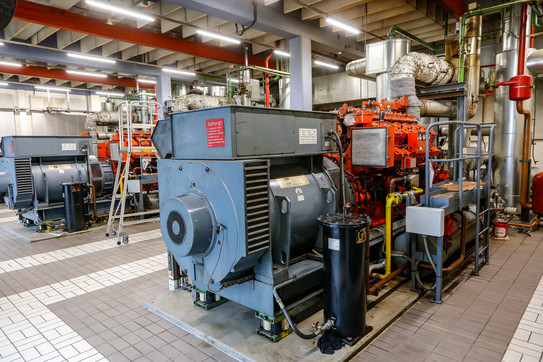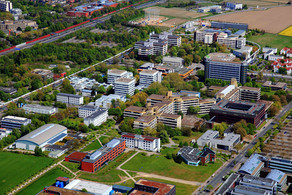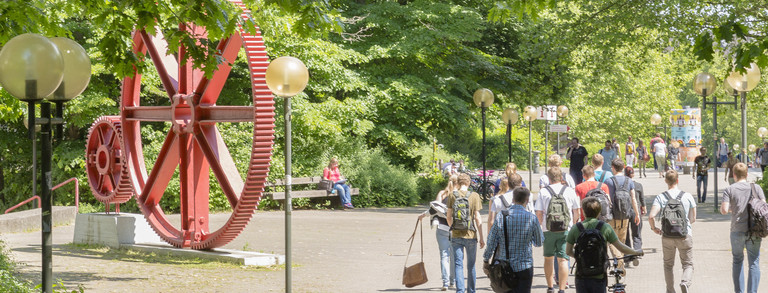Projects Realized
Combined heat and power plant
- Projekte
- 7 Bezahlbare und saubere Energie
A combined heat and power plant (CHP) is a system for the simultaneous generation of electrical energy and heat. In order to keep losses low, a CHP unit is operated at or near the place of heat consumption. Cogeneration can achieve high overall efficiencies of 80 to 90%, compared to 25 to 44% for conventional combinations of local heating and a central power plant. Here, the efficiency drops because the waste heat is not used to generate electricity.

With its combined heat and power plant, the TU Dortmund produces thermal energy with the help of three large combustion engines, which also generate electrical energy by means of connected generators. For optimal energy utilisation, in the warmer months the excess thermal energy is used by two absorption chillers to generate cooling. With this combined heat, power and cooling system, the energy contained in the natural gas is used extremely efficiently. The efficiency is about 90%. With its power plant, the TU Dortmund produces about 40% of its electricity and covers about half of its heating needs itself. The environment and the TU Dortmund benefit equally from this. And incidentally, this makes the TU one of the largest energy producers in the city of Dortmund.
In April 2016, an article on the CHP was published in unizet (issue: 02/16 | No. 447, p. 2).
Three questions for Michael Brockmeier
Dipl.-Ing. Michael Brockmeier is head of the Department of Building and Facility Management (Department 6). Among other things, he is responsible for building and mechanical engineering as well as energy generation at TU Dortmund University. Before coming to TU Dortmund in 2006, the electrical engineer worked for Bau- und Liegenschaftsbetrieb NRW.
Electricity, heating and cooling are distributed centrally on the north and south parts of the campus, including through approximately four kilometres of underground supply ducts. This allows very effective central technical energy management. A comprehensive building automation system controls and regulates all major building technology consumers. Since the technical control room is manned around the clock, manual energy-saving interventions are also possible at any time. In addition, consumption and performance values are permanently recorded and monitored automatically. Deviations from set threshold values can thus be detected immediately and are automatically signalled.
The largest amounts of energy are required for heating and ventilation. For this reason, all heating and ventilation systems are continuously optimised in terms of energy and automatically adjusted according to current outdoor and indoor temperatures. The systems are switched on and off via time switch catalogues. This also works for specific areas, for example in lecture halls. For this purpose, the room allocations from the electronic course catalogue (LSF) are used, among other things. Efficient heat recovery systems are used for ventilation systems. This means that the used but warm exhaust air is used to preheat the cold fresh air drawn in from outside by means of heat exchangers. In many buildings, the lighting in public areas is controlled depending on the outdoor light intensity or via motion detectors.
With a highly efficient combined heat and power plant (CHP) on the North Campus, TU Dortmund University generates its own electricity and heat. It can cover around 45 per cent of its electricity consumption with this. The underlying technical principle is called cogeneration. This form of energy conversion offers a very high degree of efficiency. In addition to thermal energy, electrical energy is generated in large combustion engines by means of coupled generators. The natural gas used is thus utilised to a much greater extent than would be possible by simply burning the gas. The remaining heat is also generated using the environmentally friendly energy source natural gas in three large boilers. The centrally heated heating water at up to 130°C is transported to the buildings in insulated pipelines. The cooling energy, which is needed to cool the computer centres, for example, is also produced entirely in-house and is fed to the technical cooling systems by means of approx. 6°C cold water. In the summer months, a large part of the cooling energy is generated in so-called absorption chillers by converting residual heat (one could also say waste heat) from the combined heat and power plant. Overall, this is a very economical and environmentally compatible technology. For the South Campus, we are therefore planning to replace the old and aging combined heat and power plant with a block-type thermal power station.




